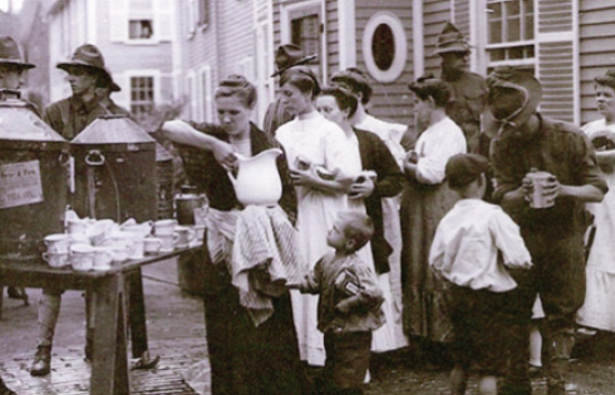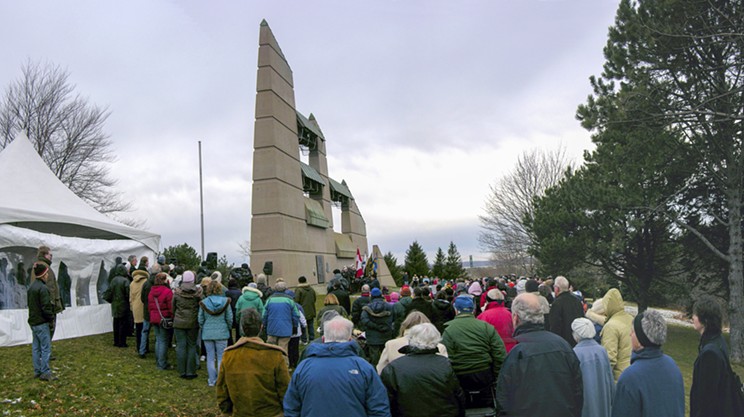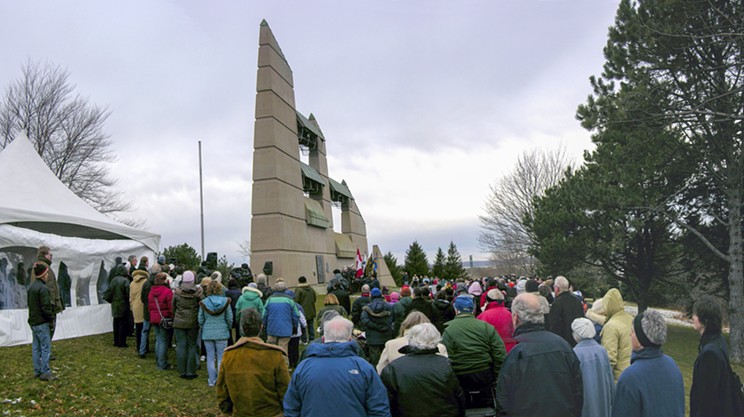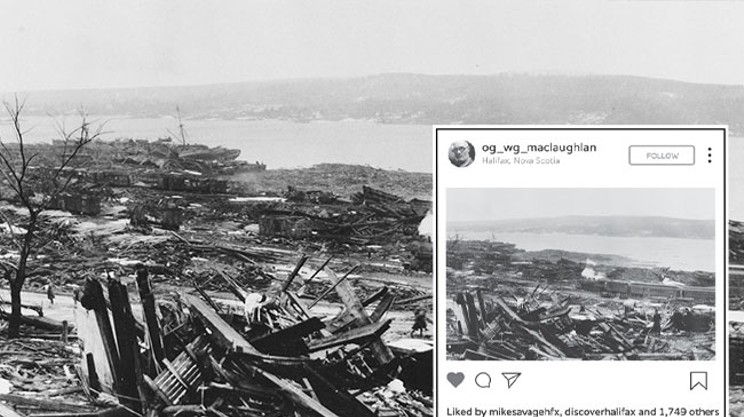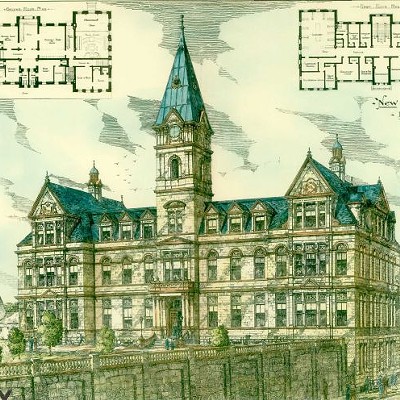Even as the fires raged on December 6, 1917, many Haligonians were seized by a sudden generosity. “Citizens came in large numbers ‘flocking’ to give us places to put people,” reported Frank Gillis, an alderman from Ward 2 in the South and West Ends and chair of the relief committee’s transportation subcommittee. “One said ‘We’ll take two families or two women or husband and wife.’” Among those flocking citizens were lieutenant Rod Macdonald, recently returned from the front, and his parents, who tried to volunteer their house for up to 25 refugees. Meanwhile, as in Salem, the army sprang into action to provide rudimentary housing for those left homeless. “Relief bands of
military were covering the Common and the slopes of Camp Hill with a mushroom-like growth of bell tents, which spring
unto being with the passing minutes as if some magical force was behind them,” wrote a breathless
Chronicle. And around six o’clock that evening, the owners of private spaces opened them as public shelters. Homeless survivors were welcomed at “St. Paul’s Hall, the Academy of Music, Strand theatre, Columbus Club, in fact in any place where some warmth and food could be given them,” Gillis recalled.
Yet the putative recipients of this generosity appeared uninterested in it. Lieutenant Macdonald was disappointed that “a little lad and one family were the only occupants” of his guest rooms. Without actual sufferers, the Macdonalds instead welcomed 25 of the nurses then flooding into the city. Nor did anyone spend the night in the army’s tents. “Unfortunately although this cot hospital was complete and very comfortable no patients could be induced to enter it,” reported medical relief chief Frank McKelvey Bell. “The patients were stunned and refused to be transferred into the tents at night.” Despite his implication that the homeless were unreasonable to refuse the heated tents, he also allowed that the “frightful blizzard,” which deposited three feet of snow around the tents by the next morning, made sleeping in them undesirable. Bell’s boss, General Thomas Benson, in his own report to Ottawa, blamed “the fact that people with homes shared what they had with the destitute, and Institutions, Halls and Theatres were thrown open.” But authorities had to cajole survivors to stay at those halls, institutions and theatres, too.
It wasn’t for lack of need. Eight-year-old Gertrude Hook lived in the north end of Dartmouth, but her father, an auctioneer, worked in Halifax next door to the Old St. Paul’s Church Hall. The proximity in everyday life may explain why, after he returned to Dartmouth to gather up his family, they all crossed the harbour again to return to the church hall. “We were way
up in the top floor,” Gertrude recalled 68 years later. “My father was covering windows with blankets and we were—many children—many people were there—that they gathered up.” After a night in the parish hall, they went to friends, where they remained until Gertrude’s mother’s brother and a half-brother of her father arrived from Ontario and took them there. After that, they moved to Detroit for a year. As the Hooks’ friends were rescuing them from the public shelter, Gillis’s committeemen were “herding
to-gether” survivors, trying to convince people to accept shelter. In the backyard of a house on Kane Street, one relief worker found a sailor and his wife who had somehow fitted up an old henhouse into a shack where they had spent the night. This couple had themselves found 11 people—including a mother and four-day-old baby and two or three small children—and invited them into the shed. Several of these people, including the sailor’s wife, were wounded. Elsewhere he found an army sergeant and four women in a cellar, all gathered around an oil stove trying to keep warm. Surrounded by death, these two groups offered not only warmth but also literal conviviality.
To relief workers and managers, the aid they offered seemed obvious: houses were destroyed and uninhabitable, and the army, people and institutions of Halifax stood ready to help. So they were confused and disappointed that so few people availed themselves of their generosity. The people they tried to help often preferred to stay in their ruined houses, in the overcrowded homes of their friends and relatives or even in hastily jerry-rigged shacks. The Hook family experience is suggestive. They initially went to an official shelter—indeed, Gertrude’s father helped to set it up—but, as soon as they could, they escaped the crowds of people “that they gathered up” and went to a friend’s house. That the objects of charity preferred other aid and support does not negate the original altruism. It does suggest, however, an uncomfortable aspect of charity: that even when offered in a spirit of genuine care, nonmutual charity carries with it a heavy burden of hierarchy that often makes it less desirable than mutual aid offered in a spirit of solidarity.
What the transportation committeemen tried to provide in those first few nights after the explosion was the first of many offers of charity—that is, aid given hierarchically by people and institutions that have more money, prestige, status, and power to people with less of these things—increasingly from the state or state-like institutions. This chapter is about how the recipients of that aid responded. The Hooks illustrate many of this chapter’s themes: survivors working together, like
Mr. Hook and his comrades creating a shelter, to support each other; the family preferring to stay in the private home of friends or relatives; and a reliance on the Nova Scotia diaspora. Haligonians, like Salemites, engaged in delicate, subtle and often tacit negotiations, seeking to maximize the material aid they claimed from the state while minimizing the autonomy and privacy the state took from them in return. To do this, they carefully inserted this new form of labor—that of applying for, managing, and retaining state benefits—into their preexisting family economies. They also mobilized their relatives in the Nova Scotia diaspora, building a new political power that came from donations from abroad. In the course of understanding these negotiations, we can see how Haligonians managed the broader family economies to which relief was added.
Progressive relief represented a trade for the state as well. In order to adjudicate applicants’ claims, the state and its agents laboured to make their family economies legible. The job of relief authorities was, in the words of Byron Deacon’s manual, to “assist families to recover from the dislocation induced by disaster and to regain their accustomed social and economic status.” In order to determine each family’s “accustomed social and economic status,” trained workers had to investigate each claim carefully, rendering the complex, informal and illegible family economy into simple, formal and legible decisions about money, housing and material goods. A key way the relief authorities rendered family economies legible was by trying to monetize all contributions. But as Christian Lantz, the Salem rehabilitation expert who came to set up the Halifax system, warned, “Rehabilitation does not mean that losses incurred would be made
good from the Relief Fund. There is no prospect that the Relief Fund will be sufficient to cover more than a very small percentage of the loss.” Had all elements of the informal economy truly been rendered legible and accounted for monetarily, the state would have gone
bankrupt. Just as applicants had to balance maximizing the aid they received with their desire to preserve their autonomy and privacy, so too did the state attempt to maximize the legibility of its citizens while still seeking to keep some labour unrecognized.
———
Rita Mariggi, a barely literate Italian immigrant, lived with her husband Cesare in a slummy, four-room apartment on the slopes of Ward 3. According to neighbourhood gossip, she “was of good character, only gay and fond of a good time”; he was a gambler and spent his money—about $15 a week, although stevedores’ wages were always uncertain—on other women. Cesare went to work early on December 6 unloading the SS Picton at the sugar refinery dock. It took four days to find his body, leaving 19-year-old Rita to fend for herself and their three children, including five-week-old Margaret. The apartment was a mess, with only two rooms habitable and even those with rotten floorboards, ruined plaster walls, and a pervasive stench from the basement. When the Relief found her two weeks after the explosion—with two sick older children and an infant, she had been unable to go looking for them—Rita asked to be moved to St. Mary’s Shelter, but the next day she changed her mind and asked for help moving to stay with her mother, who had offered to take in the family “for the present anyway.” By the spring, she still had not moved, even in the face of increasing harassment from the landlord, who wanted to demolish the building.
Despite this misery and the apparent reluctance of her mother to help, Mariggi had both formal and informal networks to help her survive. Her story shows how Haligonians—even those with the least social capital—worked to balance the formal aid of the state and the informal aid of their communities. As a widowed working-class woman, she needed to work especially hard to maintain her autonomy and independence. In early January, she expected a payment from her husband’s union (though there is no record that she ever received it). A few weeks later, she received $20 from an anonymous “Italian friend,” who promised to continue helping his compatriots “from time to time.” Neither of these was enough to support her and her children, however. In April, Mariggi put her children in an orphanage and went to work as a domestic for the woman she had worked for before her marriage. A month later, the formal apparatus of the orphanage had also failed her. She took her children back, complaining that they had been badly treated and not looked after properly; in particular, the infant had lost weight. She moved into a boarding house, which let her keep the children with her as long as she did some household chores. A month after that, though, she was forced to leave again, since her children and those of the landlord fought constantly. Mariggi moved in with her mother, but her mother also ran a boarding house and was afraid of it developing a bad reputation if her daughter and her children stayed there. Besides, it was almost unbearably crowded there, with nine sleeping in a room, three to a bed. Unable to care for the infant under these new circumstances, Mariggi turned to a childless couple, the
Carmonics, whom she knew through her late husband, and gave them her baby. Peter
Carmonic, known around the docks as Peter the Greek, ran a “questionable lodging house” for which the police were seeking a legal pretext to shut down. According to a different police report, though, the
Carmonic house was simply a sailors’ boardinghouse; dirty—like all such places, said the police chief—but reputable. Whatever the repute of the
Carmonics’ house, turning to them was perhaps the most desperate of Mariggi’s attempts to find support within her community, and she was uncertain about it. At least three times she went to the
Carmonics to take Margaret back, only to return her when she realized again that she could not take care of the baby.
The survival strategies Mariggi cobbled together with the help, albeit sometimes grudging, of her mother, the
Carmonics and her old employer
were important, but they were fragile. As a widow with children, Mariggi was particularly vulnerable. Three children were a burden to feed, clothe and house. Her gender gave authorities license to police her behavior and put her at the mercy of gossips like the woman who talked about her late husband’s gambling. Mariggi knew her vulnerability, and she tried hard to keep Margaret’s adoption a secret. She was right to be worried: once the social workers found out, they tried to put a stop to it. After Mariggi was forced to make the adoption official by going to court, Jane Wisdom, the supervising social worker, worked with William Wallace, the judge and a relief commissioner, to block the adoption. Wisdom and her colleague Ernest Blois, the superintendent of delinquent and neglected children, preferred that Mariggi
work within formal systems rather than her informal support networks. Blois told her “that Judge [Wallace] would not allow the baby to remain at Peter
Carmonic’s and that she must take it home and care for it or place it in a Home.” As a Catholic, the obvious orphanage for Margaret was the Home of the Guardian Angel—the same one in which Margaret had failed to thrive. “Mrs. Marigge said she would not put it in the Home as they did not care for it,” Blois wrote. The Protestant orphanage refused to take the baby because her parents were Catholic. The Catholic clergy, though,
were little better.
Mrs. Carmonic refused to go to church since she was convinced that the priest disliked her because, as Blois paraphrased, “she has a big house and no help.” Whatever the reason, she was certainly right that the clergyman disliked her. The priest wrote a note of “emphatic protest” against the adoption, on the grounds that because
Mrs. Carmonic “does not practice her religion herself she can hardly be expected to guarantee a religious upbringing to her adopted child.” He too wanted Margaret sent to the Home of the Guardian Angel “until Mrs. Carmonic proves she is a Catholic by doing her duty.”
The priest appeared mollified when
Mrs. Carmonic signed a contract agreeing that if she did not become a good Catholic within two years, she would give up the baby, and the case mostly disappeared from the desks of Blois, Wallace, and Wisdom. But Rita Mariggi continued for much of the rest of her life to try to balance the demands of the state’s welfare system and those of her informal network. In 1920, Mariggi had an illegitimate child, and the nurse who delivered her baby informed both the relief commission and Bessie Egan, the police matron, even though, the nurse said, Mariggi was “very anxious that H.R.Comm. should not hear of this.” She was right to be afraid; the commission cut off her funds until she agreed to put the new baby into the Home of the Guardian Angel. Already, both of her older boys were being cared for at St. Joseph’s Orphanage. Two years after that, she married a man named John Dill in a Presbyterian church. This meant that the Relief would no longer pay her widow’s pension, but the marriage presumably provided a different kind of security, one without the intrusive gaze of the state. In the next dozen years, Mariggi bore seven more children, and she continued to balance Dill’s increasing abuse with her desire to stay free of governmental intrusion in her life. In 1930, for instance, “sick and tired of getting a bawling out” from her husband, she put her eldest son—crippled in an accident three years earlier—into the City Home. She almost immediately regretted it, though, and wrote to the Relief begging help to get him out again. “There
was all kinds of men, coloured and white, crazy and sick, scrunching, hollering, cursing, swearing, ripping and tearing,” she wrote. “He doesn't want to stay there. There was no church on Sunday. Joe said ‘For God’s sake take me out of here.’” Four years after that, in the depths of the Depression, Dill demanded that the second son, a star student, leave school and either work or live at the Citadel Relief Camp, the humiliating last resort of the city’s poorest men. In the ensuing fight, Dill struck Mariggi on the side of her head. Mariggi performed a complicated balancing act between him and the state, prosecuting him for his assault before, in the words of the newspaper, “she became soft-hearted and decided she did not want to prosecute” and warned her husband that should he hit her again, he would find himself back in court. Nearly two decades after the explosion, Mariggi was still trying to maintain her independence from the state while using it to get the support she needed.
Mariggi’s was an extreme case, but it highlights the task that faced Haligonians after the explosion. Like Rita Mariggi, like the
Hilcheys, like Sarah Henry and her daughter, they wanted—needed, in many cases—the money and other material aid the Relief offered. Yet they
rejected, or tried to reject, the new bureaucratic machine that offered it. They preferred instead the reciprocal solidarity of people they knew. Unlike the cold, technocratic aid of the Relief, survivors like Sarah Ellen Powell received both material and emotional help from people they knew. To balance these two—the formal and informal, the hierarchical and reciprocal, the charity and solidarity—Haligonians had to use a variety of techniques, themselves both formal and informal. In addition to doing so as individuals and families, they did so, as we will see in the next chapter, in institutions like churches and unions.
———
Voice of the City is a platform for any and all Halifax individuals to share their diverse opinions and writings. The Coast does not necessarily endorse the views of those published. Our editors reserve the right to alter submissions for clarity, length, content and style. Want to appear in this section? Submissions can be sent to [email protected].
